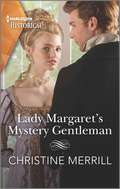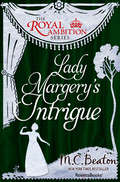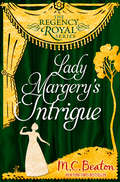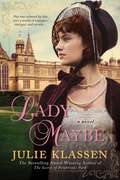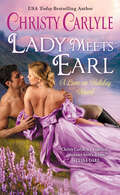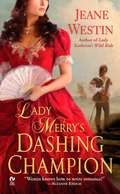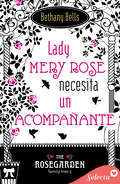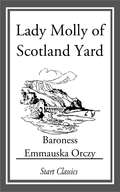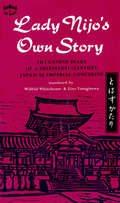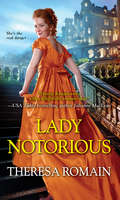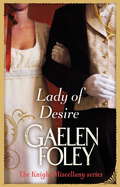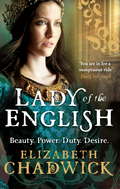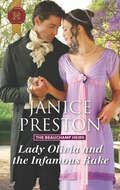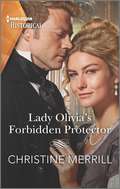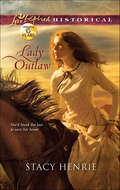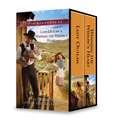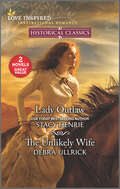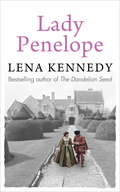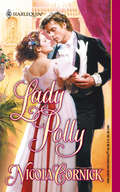- Table View
- List View
Lady Margaret's Mystery Gentleman (Secrets of the Duke's Family #1)
by Christine MerrillClose quartersWill reveal hidden truths…Desperately hoping for a season to escape her overprotective brother, Lady Margaret convinces him to hire her a dancing master. David Castell is dashing, exciting and mysterious, yet his probing questions about her family raise Margaret’s suspicions… And she discovers that her charming teacher is undercover investigating her brother for murder! Margaret’s determined to prove David wrong, but their irresistible attraction is disrupting both their plans…From Harlequin Historical: Your romantic escape to the past.Secrets of the Duke’s FamilyThe mysteries and passions of the aristocracy!Book 1: Lady Margaret’s Mystery Gentleman
Lady Margery's Intrigue (The Royal Ambition Series #6)
by M. C. BeatonTo save her home, a woman must risk her heart in this fun Regency romance from the New York Times–bestselling author of the Traveling Matchmaker series. At age twenty-three, the petite Lady Margery has already graced the rows of wallflowers for many a season. With the one exception of Charles, the Marquess of Edgecombe, the only man who ever dances with her, Lady Margery will have nothing to do with men. What&’s more, she does not even particularly like Charles. Bored beyond words, she returns to the comfort of her only love: her home at Chelmswood. But even there, she still cannot find the respite she seeks. It seems her middle-aged father has taken for himself a dim-witted brat of nineteen to be his bride. Forced into bankruptcy by his child-bride&’s lust for luxury, Margery&’s father determines to sell Chelmswood. But Margery will not hear of it and launches an all-out, military-like campaign to ensnare a wealthy husband and save her ancestral family home. Everything seems to be going according to plan until the unforeseen intervention of Charles sabotages Margery&’s plan, giving them both a run for their money.
Lady Margery's Intrigue: Regency Royal 4 (Regency Royal)
by M.C. BeatonAt age twenty-three, the petite Lady Margery has already graced the rows of wallflowers for many a season. With the one exception of Charles, the Marquess of Edgecombe, the only man who ever dances with her, Lady Margery will have nothing to do with men; what's more, she does not even particularly like Charles.Bored beyond words, she firmly decides this to be the end of it all and returns to the comfort of her only love, her home at Chelmswood. But she does not find comfort, not even there. It seems her middle-aged father has taken for himself a dim-witted brat of nineteen to be his bride.Forced into bankruptcy by his child-bride's lust for luxury, Margery's father determines to sell Chelmswood. But Margery will not hear of it and launches an all-out, military-like campaign to ensnare herself a wealthy husband and save her ancestral family home.Everything seems to be going according to plan until the unforeseen intervention of Charles sabotages Margery's plan, giving them both a run for their money.
Lady Maryann's Dilemma (Regency Romance Ser.)
by Karla HockerA fiancé deceit leads a practical lady to embrace her true passion in this Regency romance by the author of The Devilish Marquis. Having never seen a love match that didn&’t end in disaster, Lady Maryann Rivington is determined to wed for practical reasons. So the last thing she wants to hear is a slanderous accusation against her carefully-chosen betrothed. She can't imagine why the handsome stranger who approached her in the Botanic Gardens is so intent on preventing her marriage. But she is so befuddled by the passion in his eyes that she no longer feels rational in the least. Major Stephen Fant spent months gathering evidence against the man who had destroyed his brother, and now the scoundrel is finally within his reach. Though he knows it could jeopardize everything, he simply has to warn his quarry's beautiful fiancée that her betrothed is under investigation. After all, Lady Maryann is far too delectable for the likes of the lowly Lord Tammadge. And as the major gazes into her wide gray eyes, he realizes he'd do anything to keep her safe—except stay away.
Lady Maybe
by Julie KlassenIn the new novel by the three-time Christy Award-winning author of The Maid of Fairbourne Hall, a woman's startling secrets lead her into unexpected danger and romance in Regency England... One final cry..."God almighty, help us!" and suddenly her world shifted violently, until a blinding collision scattered her mind and shook her bones. Then, the pain. The freezing water. And as all sensation drifted away, a hand reached for hers, before all faded into darkness...Now she has awakened as though from some strange, suffocating dream in a warm and welcoming room she has never seen before, and tended to by kind, unfamiliar faces. But not all has been swept away. She recalls fragments of the accident. She remembers a baby. And a ring on her finger reminds her of a lie.But most of all, there is a secret. And in this house of strangers she can trust no one but herself to keep it.
Lady Meets Earl: A Love on Holiday Novel (Love on Holiday #2)
by Christy CarlyleUSA Today bestselling author Christy Carlyle sweeps readers away on an all-new romantic holiday to the wilds of Scotland where a young woman discovers her vacation home is unexpectedly owned by a strange, devastatingly handsome earl.After a lifetime of living for her friends, family, even strangers, Lady Lucy Westmont knows something must change or she’ll lose herself forever. An invitation to visit her free-spirited and scandalous aunt in the wild Scottish countryside is the perfect opportunity to discover how to live the life she wants.James Pembroke just learned that not only is he the new Earl of Rossbury, he’s also inherited his late uncle’s debts and a manor house deep in Scotland. Already owing money to an unsavory man because of a business deal that went awry, he has no choice but to travel to Scotland to sell the manor. On his way, he finds himself sharing a train car with a rather pretty but wild young woman.When Lucy manages to make it to her aunt’s home, she discovers her aunt is missing and the incredibly rude man who shared her train car is claiming that he owns the house instead. Nevertheless, Lucy is determined to have a true holiday, even if she is accompanied by the man who has upended her plans—and her heart.
Lady Merry's Dashing Champion
by Jeane WestinIt seems Meriel-called Merry-looks exactly like the wife of Lord Giles, Earl of Warborough, whose legendary heroism has long sent a thrill down Merry's spine. Giles's cold, unfaithful wife is known to be a spy for the Dutch. Coerced by the British king's spymaster, Merry takes the traitor's place as a double-agent-with the aim of delivering false intelligence to the waiting Dutch. But Merry's dangerous mission only fans the flames of her smoldering desire for Giles-even as Giles is overtaken by passion for a "wife" who's suddenly become all he ever wanted.
Lady Mery Rose busca un acompañante (The Rosegarden Family Tree #Volumen 5)
by Bethany Bells¿Acaso puede el amor ser evitado por la cláusula de un contrato? A diferencia de su hermana mayor, lady Mary Rose Rosegarden -que odia su nombre, su apellido, y las rosas en general- no quiere ni maridos ni amantes, ni montar escándalos como los que lady Roseanne ha vivido. Pero, como resulta extraño que en su segunda temporada siga sin establecer un compromiso, y sus abuelos presionan de un modo insoportable para que lo haga, resuelve seguir en eso la costumbre familiar y busca una solución, como poco, excéntrica.Así, decide contratar un acompañante por horas, de entre los amigos de sus hermanos, siempre tan endeudados. Alguien que simule ser un pretendiente a cambio de dinero, que la corteje a ojos de todo Londres, pero que tenga muy claro que jamás habrá nada entre ellos. Lo mejor quehace lord Charles Cherry en la vida es maldecirse a sí mismo. Pero ¿cómo no hacerlo, si es incapaz de ganar una sola mano de cartas en un mundo donde los caballeros poco más pueden hacer? A esas alturas casi le ha quedado claro que es un hombre de mucha suerte. Eso sí, de la mala. Aunque, en definitiva, también debe contar con una pizca de la otra, de la mejor de las fortunas, porque, justo cuando empezaba a temerse el visitar la cárcel por deudas, la hermosa Mary Rose le ha hecho una propuesta imposible de rechazar. De lo que no está tan seguro, es de si podrá cumplir todas sus condiciones y no enamorarse de ella.
Lady Molly of Scotland Yard
by Emmauska OrczyFrom the author of 'The Scarlet Pimpernell', comes a series of 12 stories featuring one of literature's first female detectives. Molly Robertson-Kirk a.k.a. Lady Molly shares the same mental prowess as C. Auguste Dupin and Sherlock Holmes but brings a woman's wit to the table making for a formidable crime buster. Join her as she solves the crimes that plague the hills and highlands of Inverness, Scotland.
Lady Nijo's Own Story
by Eizo Yanagisawa Wilfrid WhitehouseAs a historical work, the book documents the routine of long-ago court life, with its great emphasis on poetry contests, "football" games, drinking parties, and clothing (at the most tragic moment, Lady Nijo stops to describe what the messenger bringing word of her lover's death is wearing).Lady Nijo's story is much more than a day-to-day record of trivial events. It is the tale of a courageous woman, told with consummate skill. Scholoars agree that the newly-discovered diary is one of the masterpieces of the country's literature, a genuine autobiography that not only records the social pastimes of the aristocracy, but also gives a contemporary view of the political and economic movements of the time.
Lady Nijo's Own Story
by Eizo Yanagisawa Wilfrid WhitehouseAs a historical work, the book documents the routine of long-ago court life, with its great emphasis on poetry contests, "football" games, drinking parties, and clothing (at the most tragic moment, Lady Nijo stops to describe what the messenger bringing word of her lover's death is wearing).Lady Nijo's story is much more than a day-to-day record of trivial events. It is the tale of a courageous woman, told with consummate skill. Scholoars agree that the newly-discovered diary is one of the masterpieces of the country's literature, a genuine autobiography that not only records the social pastimes of the aristocracy, but also gives a contemporary view of the political and economic movements of the time.
Lady Nijo's Own Story
by Eizo Yanagisawa Wilfrid WhitehouseAs a historical work, the book documents the routine of long-ago court life, with its great emphasis on poetry contests, "football" games, drinking parties, and clothing (at the most tragic moment, Lady Nijo stops to describe what the messenger bringing word of her lover's death is wearing).Lady Nijo's story is much more than a day-to-day record of trivial events. It is the tale of a courageous woman, told with consummate skill. Scholoars agree that the newly-discovered diary is one of the masterpieces of the country's literature, a genuine autobiography that not only records the social pastimes of the aristocracy, but also gives a contemporary view of the political and economic movements of the time.
Lady Notorious (Royal Rewards #4)
by Theresa RomainWho knew love would be her secret weapon? Cassandra Benton has always survived by her wits and wiles, even working for Bow Street alongside her twin brother. When injury takes him out of commission, Cass must support the family by taking on an intriguing new case: George, Lord Northbrook, believes someone is plotting to kill his father, the Duke of Ardmore. Decades before, the duke was one of ten who formed a wager that would grant a fortune to the last survivor. But someone can’t wait for nature to take its course—and George hopes a seasoned investigator like Cass can find out who. Cass relishes the chance to spy on the ton, shrewdly disguised as handsome Lord Northbrook’s notorious “cousin.” What she doesn’t expect is her irresistible attraction to her dashing employer, and days of investigation soon turn to passionate nights. But with a killer closing in and her charade as a lady of the ton in danger of collapsing at any moment, Cass has no choice but to put her life—and her heart—in the hands of the last man she ought to trust . . . “Richly rewarding.” —Booklist, Starred Review on Fortune Favors the Wicked
Lady Of Desire: Number 4 in series (Knight Miscellany #4)
by Gaelen FoleyImpetuous beauty Lady Jacinda Knight is the daughter of a notorious woman. Her mother - Georgiana, the Duchess of Hawkscliffe - had scandalised society with her affairs and exploits, earning her the moniker of the Hawkscliffe Harlot. All her life Jacinda has been aware that the eyes of the ton are upon her - waiting for her to reveal her true colours and follow in her disgraced mother's footsteps. Now - faced with the prospect of an arranged and loveless marriage - Jacinda may well be about to prove her critics right. Running from her fate, Jacinda finds herself alone on a dangerous street face-to-face with Billy Blade, the notorious leader of a band of thieves. Jacinda finds herself dangerously attracted to the handsome, mysterious rogue and only just escapes the experience with her reputation intact. But Billy is no ordinary criminal. Years before he had turned his back on the privilege and power of his tyrannical father, the Earl of Rackford, a small price to pay for the freedom he currently enjoys. But Jacinda makes him contemplate the unthinkable - returning to the civilised world to reclaim his title.
Lady Of The English
by Elizabeth ChadwickTwo very different women . . . Linked by destiny and a power struggle for the English crown.Empress Matilda, daughter of Henry I, is determined to win back her crown from Stephen, the usurper king, against all odds and despite all men. Adeliza, Henry's widowed queen and Matilda's stepmother, has always been on Matilda's side but now she is married to William D'Albini, a warrior of the opposition. In a world where a man's word is law, how can Adeliza obey her husband while supporting Matilda, the rightful queen?What does it cost to be 'Lady of the English'?
Lady Of The English
by Elizabeth ChadwickTwo very different women . . . Linked by destiny and a power struggle for the English crown.Empress Matilda, daughter of Henry I, is determined to win back her crown from Stephen, the usurper king, against all odds and despite all men. Adeliza, Henry's widowed queen and Matilda's stepmother, has always been on Matilda's side but now she is married to William D'Albini, a warrior of the opposition. In a world where a man's word is law, how can Adeliza obey her husband while supporting Matilda, the rightful queen?What does it cost to be 'Lady of the English'?
Lady Olivia and the Infamous Rake (The Beauchamp Heirs #1)
by Janice PrestonHow utterly mortifying to be rejected by a rake!Sneaking off to Vauxhall Gardens lands Lady Olivia Beauchamp in a bit more trouble than she expected—but after being plucked from peril by resolute bachelor Lord Hugo Alastair, she is secretly outraged that he doesn’t even try to steal a kiss! He’s a notorious rake among the ton, and as a result, utterly forbidden to an innocent debutante like her—the daughter of a duke, no less. But their attraction is magnetic. Will she risk her reputation for a passionate encounter?Praise for the romances of Janice Preston“One of the deepest, most lovable heroes I’ve read about in quite some time.” —All About Romance“A captivating, sweet tale.” —RT Book Reviews
Lady Olivia's Forbidden Protector: A sexy Regency romance (Secrets of the Duke's Family #2)
by Christine MerrillAn irresistible connectionBut an improper match?Determined to marry on her own terms, Lady Olivia Bethune has arranged a convenient elopement, but her plot is thwarted when Michael Solomon is hired to watch over her. Her jaded protector stirs a grudging respect—and an illicit desire—in Liv. Their stolen kisses have her believing both love and her freedom might be possible. Can she convince Michael that he&’s not just another play for her independence?From Harlequin Historical: Your romantic escape to the past.Secrets of the Duke's Family The mysteries and passions of the aristocracy!Book 1: Lady Margaret's Mystery GentlemanBook 2: Lady Olivia's Forbidden Protector
Lady Outlaw
by Stacy HenrieNo one would ever imagine a fresh-faced young woman could be robbing stage bandits of their ill-gotten fortunes. But Jennie Jones is desperate to save her family's ranch from foreclosure. And the risks seem worth it, until her upright new ranch hand offers a glimpse of how much is really at stake.Former bounty hunter Caleb Johnson is ready for a new, clean start. With a woman like Jennie, he could build a future there in Utah territory. But only if his gentle faith can guide her in a choice between the land she's fought so hard to save and a future by his side.
Lady Outlaw & Winning the Widow's Heart: Lady Outlaw\Winning the Widow's Heart
by Sherri Shackelford Stacy HenrieFall in love with these heartwarming classic Western historical romances by USA TODAY Bestselling Author Stacy Henrie and fan favorite Sherri Shackelford!Lady Outlaw by Stacy HenrieNo one would ever imagine a fresh-faced young woman could be robbing stage bandits of their ill-gotten fortunes. But Jennie Jones is desperate to save her family’s ranch from foreclosure. And the risks seem worth it, until her upright new ranch hand offers a glimpse of how much is really at stake.Former bounty hunter Caleb Johnson is ready for a new, clean start. With a woman like Jennie, he could build that future here in Utah territory. But only if his gentle faith can guide her in a choice between the land she’s fought so hard to save, and a future by his side.Winning the Widow’s Heart by Sherri ShackelfordWhen Texas Ranger Jack Elder stormed the isolated Kansas homestead, he expected to find a band of outlaws. Instead, the only occupant is a heavily pregnant woman—and she’s just gone in to labor. A loner uneasy with emotion, Jack helps deliver widow Elizabeth Cole’s baby girl and can’t get back on the trail fast enough. The robber and murderer he’s after killed one of Jack’s own—and he vows to catch the man. But when he returns to check on Elizabeth and her little one, he discovers that she may hold the key to his unsettled past—and his hoped-for future.
Lady Outlaw and The Unlikely Wife
by Debra Ullrick Stacy HenrieTwo most surprising women…Lady Outlaw by Stacy HenrieNo one would ever imagine that a fresh-faced young woman could be robbing stage bandits of their ill-gotten fortunes. But Jennie Jones is desperate to save her family’s ranch from foreclosure. And the risks seem worth it. Until her upright new ranch hand, former bounty hunter Caleb Johnson, offers a glimpse of how much is really at stake…The Unlikely Wife by Debra UllrickRancher Michael Bowen’s bride, married by proxy, is not what he expected. With her trousers, cowboy hat and rifle, Selina Farleigh Bowen looks like a female outlaw, not the genteel lady he corresponded with. Selina loved Michael’s letters, even if she couldn’t read them herself. A friend read them to her and wrote her replies—but that “friend” left things out. Yet time might show Michael the true value of his unlikely wife.USA TODAY Bestselling Author
Lady Penelope: A tale of romance and intrigue in Queen Elizabeth's court
by Lena KennedyA gripping story of romance, lovers and a life filled with intrigue . . .Warm-hearted and wilful, her temper as fiery as her beautiful auburn hair, Lady Penelope is a romantic heroine whose impulsive nature makes her as many enemies as her vivacious, flame-haired beauty wins her admirers.Caught up in the dangerous intrigues of Queen Elizabeth's court, forced to marry a wealthy but repulsive nobleman, she pours all her passion into her children . . . and her lovers. Will Penelope survive her loveless marriage and a life filled with tragedy, and finally emerge triumphant?******************What readers are saying about LADY PENELOPE'Perfect!' - 5 STARS'My favourite novel' - 5 STARS'I love the history behind the book' - 5 STARS'Loved it . . . Penelope was a brilliant character' - 5 STARS'Good from start to end' - 5 STARS
Lady Penelope: A tale of romance and intrigue in Queen Elizabeth's court
by Lena KennedyWarm-hearted and wilful, her temper as fiery as her beautiful auburn hair, Lady Penelope is a romantic heroine whose impulsive nature makes her as many enemies as her vivacious, flame-haired beauty wins her admirers.Caught up in the dangerous intrigues of Queen Elizabeth's court, forced to marry a wealthy but repulsive nobleman, she pours all her passion into her children . . . and her lovers. But though her heart often rules her head, Penelope survives her loveless marriage and a life filled with tragedy to emerge triumphant.
Lady Pirate
by Lynsay SandsOut of the frying pan...Circumstances had changed; they had gotten worse. Valoree no longer had to masquerade as her murdered brother and scourge the oceans as Captain Red. She no longer had to command his pirate band in a quest to regain his birthright. She had been named heir to Ainsly Castle. But no executor would ever hand over the estate to an unmarried pirate wench and her infamous crew--no matter to whom she'd been born. And the will had distinctly stated that in order to inherit, Valoree must be married to a nobleman...and pregnant.Into the fire...Upon learning that, the virgin captain had been ready to return to the seas, bur her crew had put it to a vote--and for those rascally cusses she would do anything. Reluctantly, she agreed. If they could find a way--Henry and One-Eye and Slully--to put on her a sweet face that would fool the ton, she would handle the rest. Even with a drunken prostitute as an "aunt" and her merry cutthroat crew as "servants." But to herself she swore one thing: she could only marry a man who fired her blood, a man who was not afraid of a ...Lady Pirate.
Lady Polly
by Nicola CornickEven as Lady Polly rejected another proposal of marriage, her heart burned for the man she'd rejected five years ago. She'd heard that in his misery, her beloved Lord Henry Marchnight had become a rogue and a gambler. But when he appeared before her on a deserted terrace and stole a kiss, Polly knew that her passion hadn't died. The man still knew how to steal her reason with one touch. But reason she needed as suspicions of criminal behavior hovered about Lord Henry. Should she return to her routine of spurning suitors? Or should she do what she should have done five years ago--trust her love and follow her heart...?
